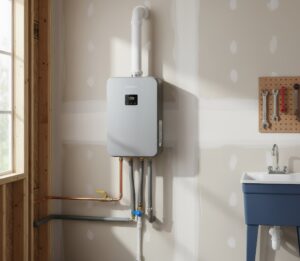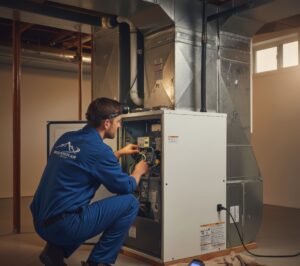Most Calgary homeowners who wake up on a winter’s morning to a cold house due to a furnace on the blink will call a professional HVAC company to troubleshoot the problem. That’s generally the right thing to do, especially if you’ve never done any furnace troubleshooting before and you don’t really know one part of a furnace from another. It’s best not to take chances. When gas and electricity are involved, there’s always the risk of something serious going wrong. Furnaces are complex appliances and, most times, you can’t simply pick up the manual and expect to find a solution. The golden rule is to contact a licensed professional to fix furnace problems. That said, some common problems with furnaces can be identified by most Calgary homeowners with just a little investigation — and a few problems require only some basic effort to fix. Almost anyone can replace an air filter, after all. Here, we’ll look at nine common furnace problems that you can troubleshoot yourself — and may even be able to fix — before calling your HVAC repair company: Before we get into the main common furnace problems, a quick recap on how forced-air furnaces work, so that you have the troubleshooting background you need for a successful investigation!
How furnaces work
If you’re like 82 percent of homeowners in Alberta, you use a forced-air furnace as the primary method of heating your home. This heating appliance uses natural gas combustion to heat the air. Cold air is taken in, cleaned with an air filter, heated with a gas burner and then blown throughout the home via a network of ducts and vents. When the heated air cools, it returns to the furnace through return air grilles and ductwork, passes through the air filter and into the furnace. That’s one complete “heating loop”. All new furnaces sold in Canada are high-efficiency appliances (95 percent minimum AFUE) though some older furnaces (15 years old or more) are standard, relatively low-efficiency models. Most modern furnaces run like workhorses if the installation has been carried out by reliable HVAC professionals. They only require an annual or half-yearly furnace tune-up to maintain smooth performance. However, sometimes things go wrong. When that happens, a few simple furnace troubleshooting measures can prevent unnecessary callout charges to HVAC professionals. Here’s how you can check the most common furnace problems we encounter in Calgary homes:
1. Poor indoor air quality
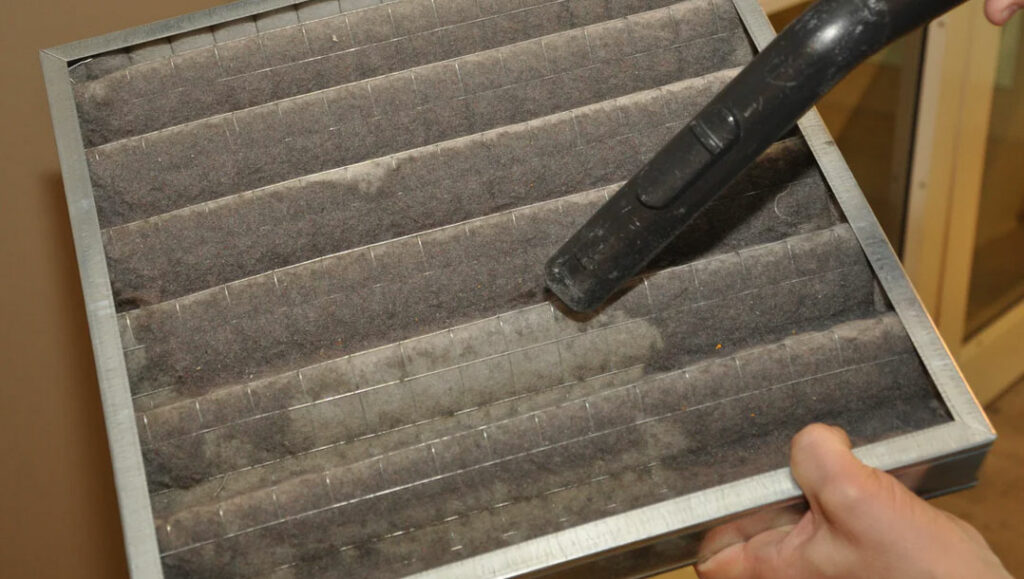
If you’ve noticed a deterioration in the indoor air quality of your home, it could be due to a dirty furnace filter. Filters gather dust and dirt, which will eventually clog the system and impede airflow unless they are cleaned or replaced regularly. Dirty filters cannot effectively block dust, debris and other materials from entering your home, ultimately damaging the quality of the air that circulates in your home. Clogged filters can even shut the system down entirely, cause damage to the heat exchange and increase energy bills. Ideally, furnace air filters should be checked every month and replaced every 3-6 months so it’s a good idea to set reminders on your phone to manage this simple task.
Troubleshooting this furnace problem
If your indoor air quality is poor and you suspect a dirty filter may be the cause, you can follow these simple steps:
- Turn the thermostat and the furnace switch off.
- Locate the air filter: this is usually in the blower compartment (accessible through a metal door or hatch on the bottom half of the furnace), in a sliding compartment by the air handler or on a rack installed on the furnace’s side.
- Remove the filter and hold it up to the light: if light cannot pass through it easily, it should be cleaned or replaced.
- If you need to clean your filter*, first use a vacuum cleaner (If necessary) and then rinse it with plain, warm water. Wash it with gentle household soap, gently scrubbing away the grime with a soft brush and then rinse it again. Wait for the filter to dry before returning the filter to the furnace.
- You can replace your gas furnace filter at any decent hardware store in Calgary. They cost $10-20 and you can usually buy packs of multiple filters for discounts. When installing the filter, the arrows should point in the direction of the airflow.
- Once the process is completed, make sure that you secure the access panel of the furnace and turn it back on
*Note that not all filters are reusable. Make sure you have a washable filter before attempting to clean it.
2. The furnace is not warming air to the required temperature
Sometimes, the furnace is working, the thermostat is working (and set to the right position) and warm air is blowing out of the furnace — but not as it should be. If the furnace is not heating the home to the required temperature, it could be for several reasons. One of the simplest reasons is, again, that the filters are dirty and clogged and are restricting airflow, i.e., not enough warm air is circulated in your home to adequately heat it. Remember, your furnace blows air through the air filter to provide air throughout the home. If the air filter is dirty, it will become more difficult to pass air through the system. This will produce cool spots in your home. However, another common furnace problem that may prevent your home from heating to the right temperature is a faulty or poorly set HVAC thermostat.
Troubleshooting this furnace problem
The first furnace troubleshooting step to take is to repeat what you did in step one: check your air filter and clean/replace it if necessary. If the problem is not the air filter, it may be the HVAC thermostat you’re using. To troubleshoot this furnace problem, follow these steps*:
- Firstly, ensure the thermostat is set to “HEAT”. Try setting the temperature at least a few degrees higher than the current room temperature. Your furnace must heat first before the bower comes on so be patient when checking this step.
- Check the thermostat batteries and replace them if necessary. If you have a programmable thermostat (common for modern furnaces), the “low battery” warning may flash on the control screen.
- Some malfunctioning older thermostats can be opened up and gently dusted around the metal coils and contact plates with a soft paintbrush to remove dust and dirt.
- Make sure that your thermostat is not receiving any false readings from other heat sources, such as sunlight, lamps, ovens, space heaters, etc.— as this information will be communicated to your furnace and may prevent it from heating your home properly. If so, you may need to ask an HVAC professional to assess the situation and relocate the thermostat.
If neither of these troubleshooting steps fix the “lack of warm air” problem, it’s time to call your licensed HVAC professional to investigate a little deeper. The furnace and thermostat may not be matched properly, which will lead to underheating (or overheating) of your home. A licensed professional can check and fix this problem. *The four basic types of thermostats available are non-programmable, programmable, Wi-Fi and smart furnaces. Troubleshooting each type of furnace may require slightly different steps.
3. The furnace is not working at all

Image by Freepik
The furnace not working in midwinter is every Calgary homeowner’s nightmare. If it’s not working at all, i.e., it’s not switching on, this could be for a number of reasons. Again, an extremely dirty filter may cause the system to shut down completely but, hopefully, you haven’t allowed the filter to get that dirty. This furnace problem is most likely due to another reason — either another furnace component or the power supply.
Troubleshooting this furnace problem
Check the simple things first (this applies to troubleshooting most furnace problems). *
- Is the front panel properly secured? Make sure that you follow the manufacturer’s instructions and, in particular, press in the panel all the way. Otherwise, most modern furnaces won’t start because of inbuilt safety switches.
- Check the furnace switch, which is usually mounted on the side of the furnace or a nearby wall. The switch can be accidentally knocked to the OFF position. That’s the first and most basic power problem to rule out.
- Make sure that your furnace is off and check that the power is turned on at the breaker box/fuse box at the electrical panel.
- Ensure the HVAC breaker is on. The switches should be labelled correctly as “furnace” or “HVAC”. In the absence of any labels, is there one breaker switch in the opposite direction to the rest? This is known as a “tripped breaker”, which usually happens due to an electrical fault. If so, switch it back on and see if this solves the power problem.
- If necessary, you can reset your breaker by flipping the switch off and back on again (there should be a click).
- Check the fuse box. Is there a melted or discolored fuse? If so, unscrew it and replace it with the same size/type (take it to the hardware store and buy a matching one).
- Turn the furnace on with the switch and see if it starts firing up. If there is still no power, it’s time to call a licensed HVAC professional.
*Safety first. When investigating any electrical issues, make sure that the furnace is off and your hands and feet are completely dry before attempting to reset the power. Tripped breakers and fuse problems can indicate wider electrical issues. If in doubt, call an electrician or licensed HVAC professional.
4. The pilot light is out or discolored

New, high-efficiency condensing furnaces have generally replaced the need for a pilot light by using electric starters. But if you have an older, conventional furnace (that vents exhaust gases through chimney flues rather than through PVC piping), it is likely to use a standing pilot light. The pilot light is a little blue flame that ensures that the burners in the furnace are ignited on demand and, for safety reasons, gas doesn’t flow through the burners until there’s a flame ready to ignite them. If the pilot light goes out once, it may have been caught in a draft and extinguished. This is nothing to worry about. However, if the pilot light keeps going out or the flame becomes discolored, this may point to a common furnace problem that needs troubleshooting…
Troubleshooting this furnace problem
If the furnace flame is out:
- Turn off the gas supply for 10-15 minutes before attempting to relight it.
- Consult the furnace manual about how to relight it safely.
- If you smell gas, you may have a leak and should evacuate the household and call a gas or HVAC professional immediately from outside the home.
Sometimes, the orifice of the pilot burner may need cleaning, dirt in the gas tube causes a blockage or the thermocouple (a temperature sensor) may be faulty, which causes the gas supply to shut off. With any of these common furnace problems, a professional can clean the necessary components and get your pilot light up and running again. If the furnace flame is anything but a healthy blue color (with a small yellowish tip), you should turn off the furnace and call a professional. There should be no major red, yellow, purple, green or other coloration to the flame.
5. The electric ignition keeps failing

Most modern furnaces use an electric ignition system to ignite the gas burners rather than a standing pilot light. Generally, this system incorporates one of the following:
- An intermittent pilot, which uses an electronically controlled high-voltage electrical spark to ignite the gas pilot.
- A hot-surface ignition system, which uses an electronically controlled resistance heating element (similar to a light bulb filament) to ignite the gas burner.
A problem with the electric ignition system can prevent a furnace from producing enough (or any) heat or might lead to “short-cycling” (this is explained later) or the blower motor running constantly.
Troubleshooting this furnace problem
The troubleshooting steps outlined in other points in this post may address this problem, especially replacing air filters and checking the furnace’s power and gas lines. Otherwise, call a professional to inspect your furnace and troubleshoot the problem.
6. Some rooms aren’t heating up properly

If your furnace is running but the rooms in your home aren’t all heating up as required, it could be down to improper airflow preventing the warm air from reaching the right places through the vents and registers. They might be blocked or even closed and this will need to be checked as a first step. There is a myth among some Calgary homeowners that closing off vents and registers in unused rooms will save energy and money. However, doing this is likely to end up causing more problems for your heating system. Blocked vents and registers can damage your entire furnace system, causing duct leaks due to excessive air pressure building up. That could result in extra wear and tear and expensive furnace repairs down the line. If closed or blocked vents are not the reason why your rooms aren’t heating up properly (and it’s not due to dirty air filters), you’ll likely need a professional inspection to troubleshoot this common furnace problem. Even a simple piece of furnace maintenance like duct cleaning can quickly solve the problem and improve the situation.
Troubleshooting this furnace problem
The basic steps to check for proper airflow through your home are as follows:
- Inspect the supply and return grilles throughout your entire home — are they all fully opened and unobstructed?
- Remove any furniture that could be blocking the wall vents and preventing warm air from reaching the rest of the room.
- Check if long, heavy curtains are obstructing air flow from vents in external walls under the windows.
- Check that rugs or furniture are not blocking any floor vents.
7. Frequent short cycling
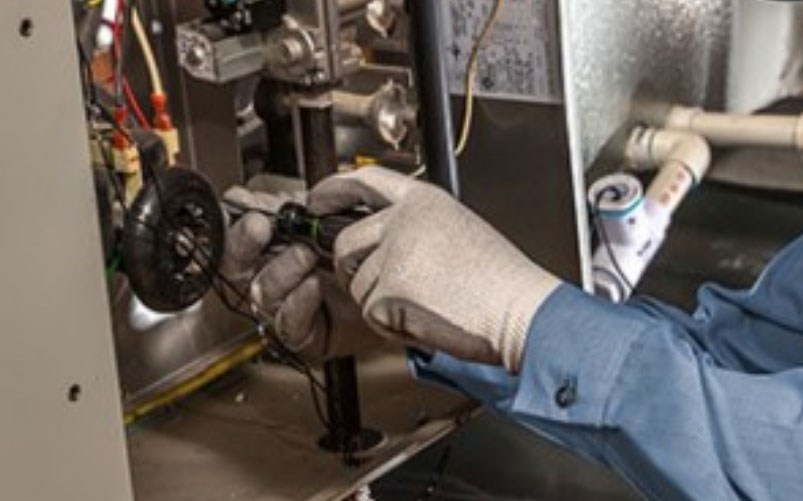
If your furnace keeps starting up and shutting off, we call it “short cycling”. That means it’s not completing the heating cycle. For instance, say you set the thermostat in your home to 20 degrees Celsius. The furnace may heat the room to 17C, then shut down and never reach the desired temperature. If you can hear the furnace starting and stopping too regularly (most homeowners become familiar with the “usual” sounds of their homes quite quickly), it’s a sign that you need to do a little furnace troubleshooting. Addressing a short-cycling issue can help prevent increased energy bills (starting and stopping the heating system uses a lot of energy) as well as damage to the furnace components. However, note that very cold weather will initiate more “activity” in the furnace than usual — the furnace needs to work harder to maintain a comfortable temperature in the home.
Troubleshooting this furnace problem
Some of the furnace troubleshooting steps taken to investigate and fix the above problems also apply to this one. Short cycling may be caused by a dirty air filter or a faulty thermostat, for instance. Another short-cycling troubleshooting step is to rule out that the exhaust vents are blocked. Many new furnaces do not vent through chimneys but instead have their fresh air intakes and exhausts set up to run through the side of the home. If this is the case with your furnace:
- Check that deep snow, windblown leaves, insects or other debris are not blocking the exhaust vents.
- If there is an exhaust vent issue, call a licensed HVAC technician about alternative venting solutions for your heating system.
8. The furnace blower runs constantly
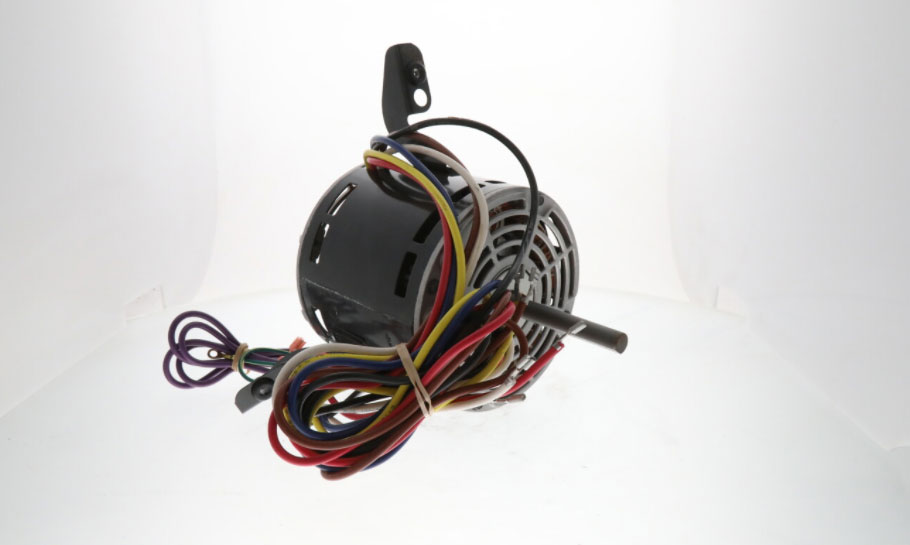
With a healthy furnace, the blower motor turns on the fan, which helps circulate air through the furnace and create uniform temperatures throughout the home. It is one of the main components in an HVAC system, forcing air out of the system and into the rooms of your home. If the system is working well and you’ve set the thermostat correctly, the HVAC fan will usually run for two or three cycles per hour. However, some homeowners do set the fan to run constantly when they want to filter the air or dry out a house that is too humid. If you usually have your fan set to run periodically but can hear your furnace blower all the time, something may be wrong. At the very least, the problem may wear out the blower motor.
Troubleshooting this furnace problem
There are two simple, common reasons for the blower to run constantly and these can often be fixed by a homeowner without too many concerns:
- If the thermostat is set to the FAN setting, the blower will run constantly. Change the setting back to AUTO on the thermostat and this should correct the problem, ensuring that the fan only runs when the system is heating and cooling.
- The fan limit control switch could need resetting or replacing. This safety device monitors the temperature inside the furnace and will shut off the system components when the temperature limits are hit. You can reset the control switch simply by reading the relevant section of your furnace’s manual and pressing the appropriate button (there’s usually a white switch inside the furnace’s heating duct). If it needs replacing, though, call a professional.
9. The furnace is too noisy

Modern furnaces make little noise when they run and should purr along in the background most of the time. On starting up, even a new furnace usually produces some noises as the heating cycle starts. You may hear a “pop” or “click” as the system fires up. These noises are normal and no cause for concern. If, however, you notice excessive humming, loud banging, high-pitched squealing or other strange noises coming from your furnace at any time, it’s not a good sign. This will require some troubleshooting to see what the problem is with your heating system. Ignoring noises can increase the furnace repair bill later on if you’re careful.
Troubleshooting this furnace problem
It’s best not to try to solve furnace noise problems yourself as they may require opening up your furnace or testing specific components. If none of the troubleshooting steps described above solve your furnace problem, it’s time to remind yourself of the golden rule…
If in doubt, call a licensed HVAC professional
Regular furnace maintenance (especially immediately before winter) will help protect the investment you made in your furnace, prevent problems and keep your family comfortable. But it won’t guarantee that issues won’t crop up during the many years your furnace is with you. The basic furnace troubleshooting steps covered here can help you get your furnace back up and running again or simply diagnose the issue while you await your HVAC company to come out and inspect your furnace. Consulting your manual can also help but if in doubt about heating (or cooling) equipment, remember the golden rule: call a licensed HVAC professional, who will have the know-how, experience and equipment to get your furnace firing efficiently again. A regular maintenance contract should give you the peace of mind that you won’t need to do any troubleshooting of common furnace problems for the foreseeable future. Call Alberta Mountain Air at 403-236-4366 contact us online if you’re in Calgary and experiencing any furnace problems. All of our furnace professionals are SAIT-certified and highly trained to get the job done efficiently.


